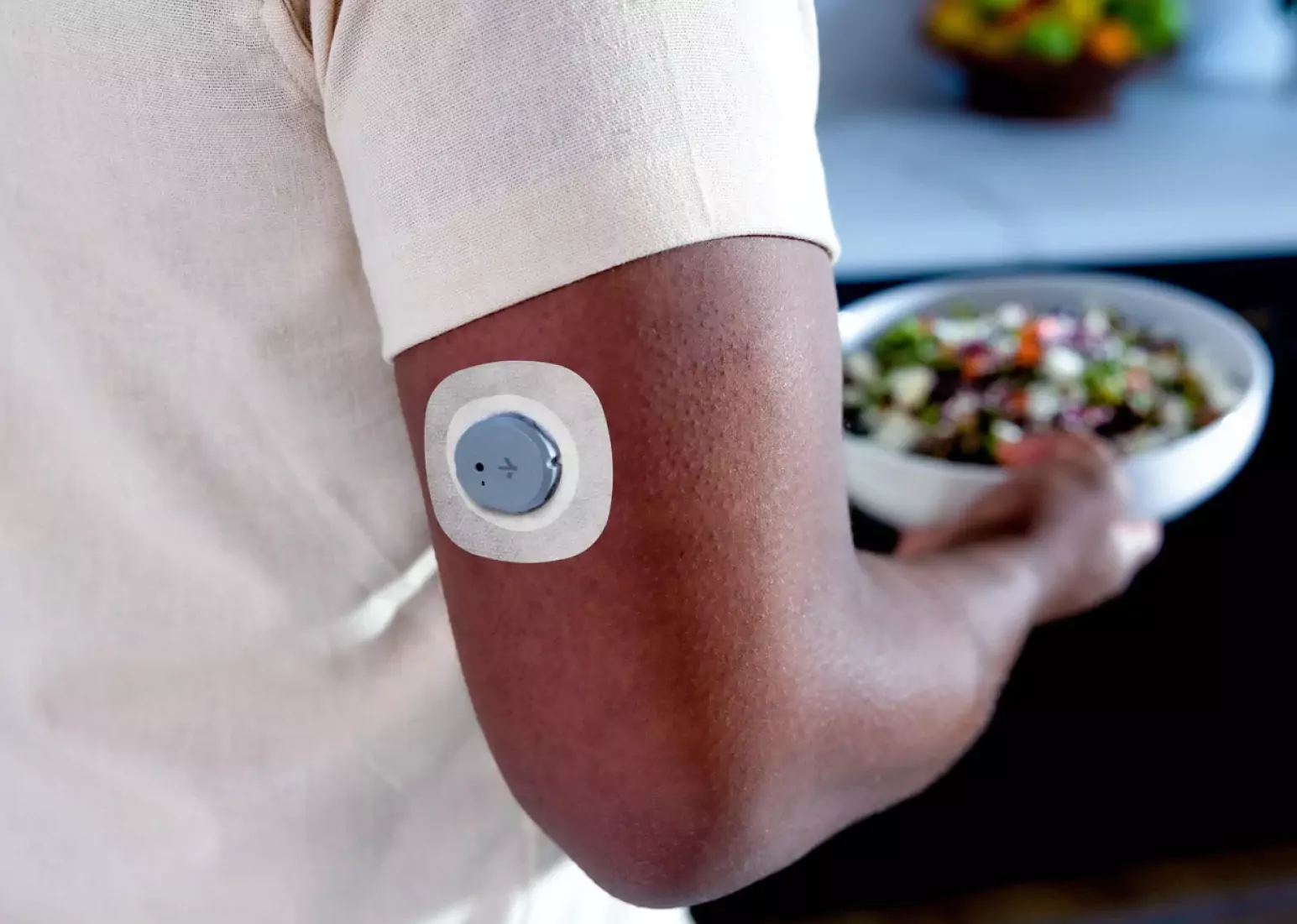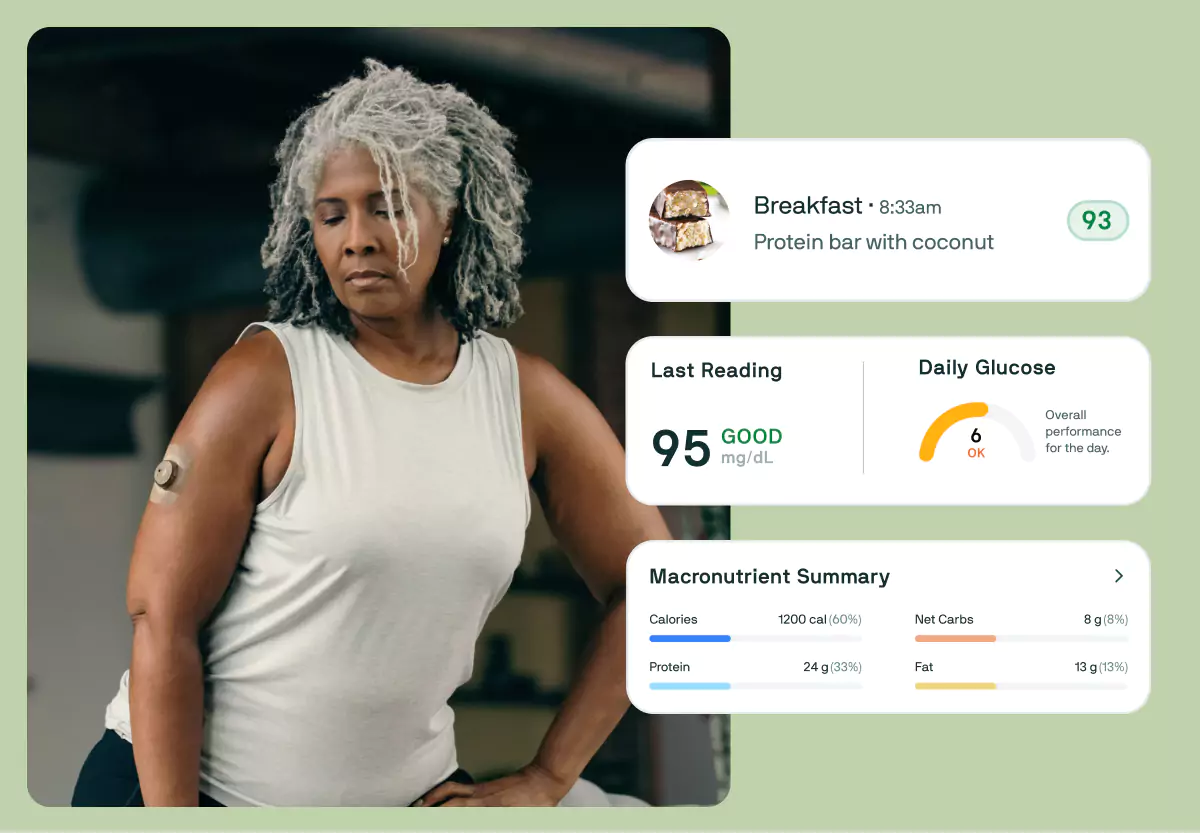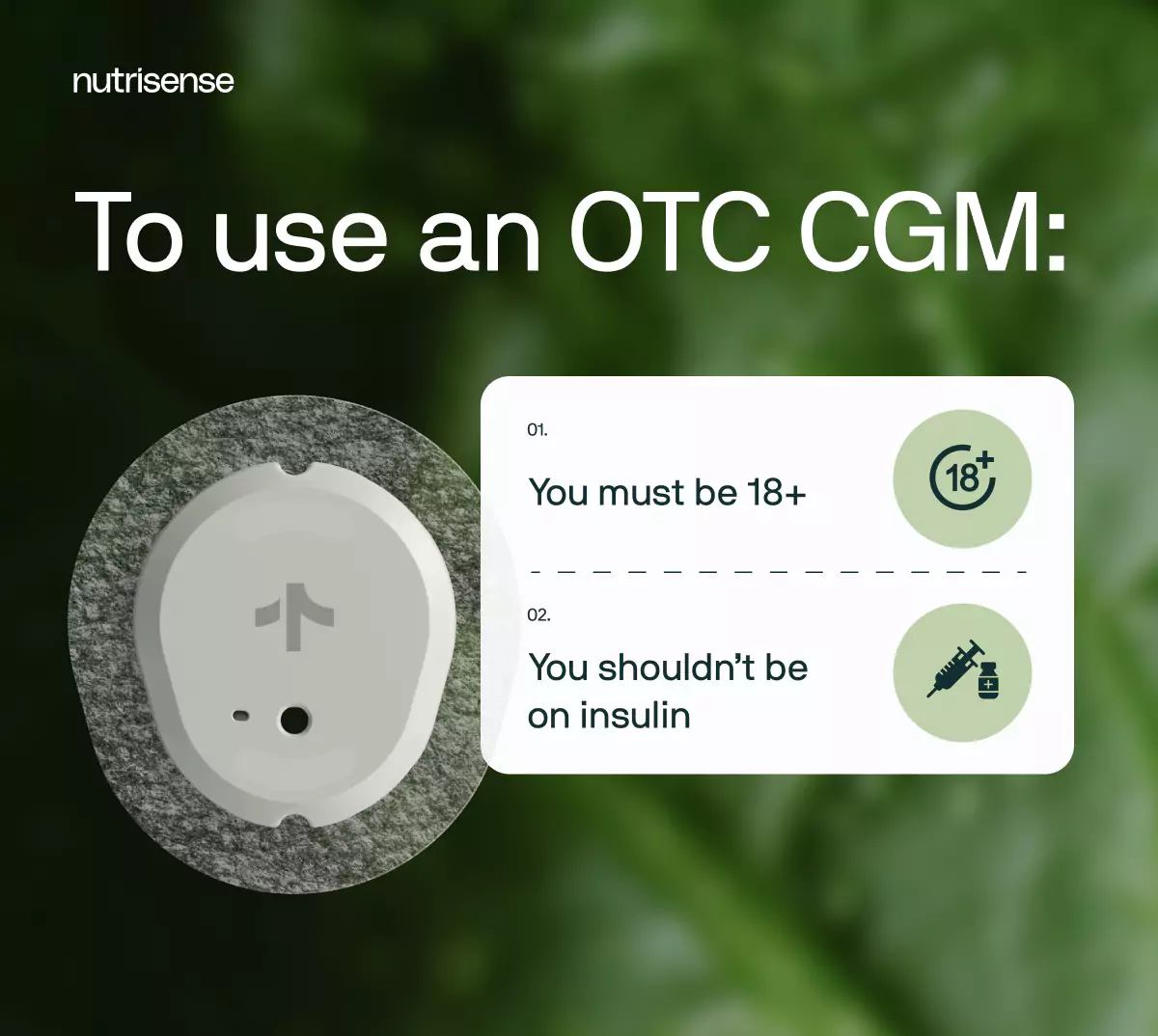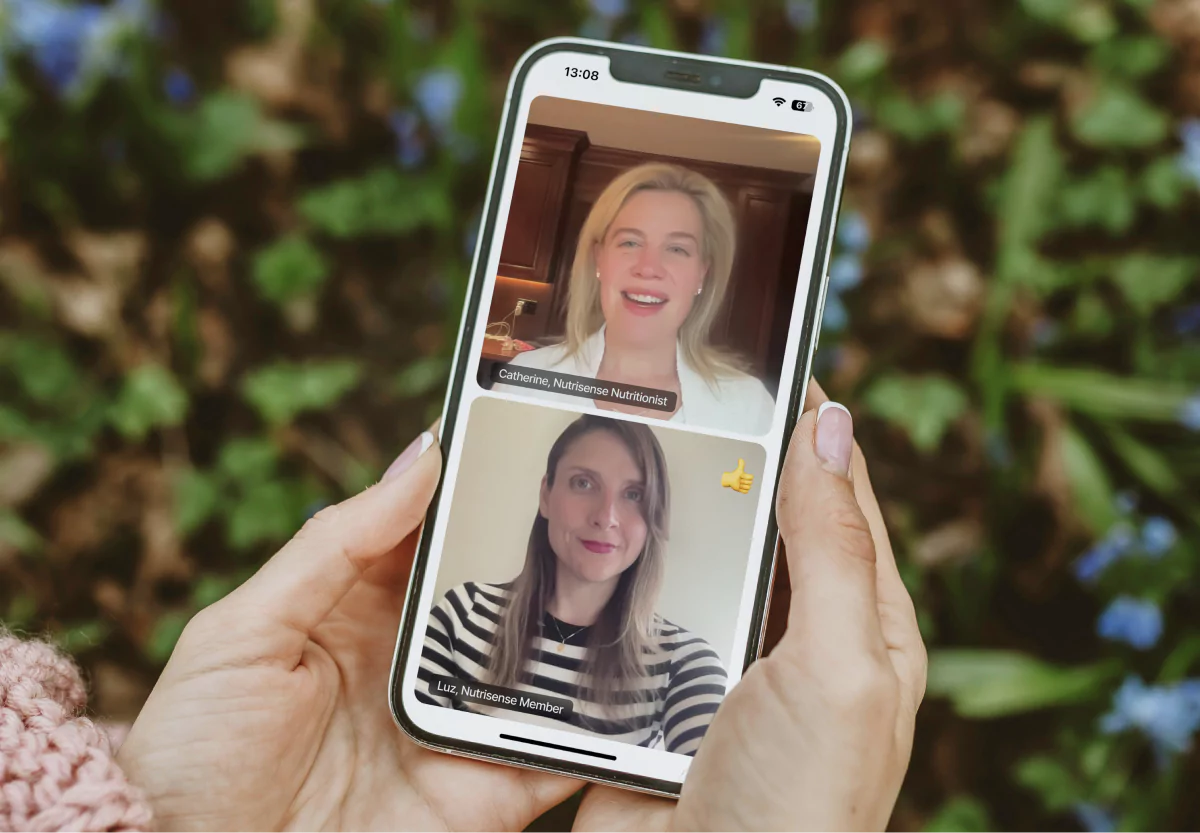Over-the-Counter CGMs — The Essential Guide

Key Takeways
Continuous glucose monitors (CGMs) and glucose biosensors provide insights into glucose levels, helping you make better-informed decisions about your health and lifestyle.
Traditionally, CGMs were prescription-only, but you may have heard of the release of over-the-counter (OTC) CGMs and glucose biosensors, including the Stelo Glucose Biosensor, Lingo, or Libre Rio. OTC CGMs and biosensors can make this technology more accessible as a wearable device for non-diabetics and those with conditions like prediabetes or type 2 diabetes who don’t use insulin—so everyone can learn more about how to manage glucose levels proactively.
Of course, whatever CGM, glucose biosensor or wearable you’re using, interpreting the information accurately requires expertise. That’s why working 1:1 with a glucose expert (like the registered dietitians and nutritionists at Nutrisense) can help you use this data to make informed choices about your health.
Curious about over-the-counter CGMs? Read on to see what our experts found out.
What are Over-The-Counter CGMs and How Do They Work?
All CGMs, whether prescription or OTC, use a small sensor, typically inserted painlessly on the back of your arm. The sensor measures glucose levels and transmits data to a smartphone app or a monitor. This process of continuous monitoring helps you identify trends and understand the impact of different foods and activities on your glucose levels.
Recent FDA Approval for OTC CGMs and Biosensors
In March 2024, the U.S. Food and Drug Administration (FDA) approved the first over-the-counter device, a major milestone in metabolic health management.
- The first approval was for Dexcom’s Stelo Glucose Biosensor System.
- In June 2024, the FDA also cleared Abbott’s Lingo biosensor.
Stelo by Dexcom, Lingo and Libre Rio by Abbott
The first OTC glucose device to receive FDA approval, the Stelo Glucose Biosensor, is from Dexcom, which also provides the prescription-only CGM systems Dexcom G7 and Dexcom G6.
Other over-the-counter CGMs include Abbott’s Lingo and Libre Rio. Abbott also makes prescription-only CGMs like the FreeStyle Libre and Libre 3, among others.
As OTC CGM users begin to monitor their glucose levels, they may realize the complexity of interpreting their CGM data. This is where services like Nutrisense come in. Nutrisense offers 1:1 support from nutritionists who are glucose-trained and certified, with years of experience analyzing biosensor and CGM data. So you have expert guidance to help you make informed decisions about diet, exercise, and lifestyle.
Why is Interpreting Glucose Monitor Data so Challenging?

Understanding the nuances of glucose fluctuations is important to get the most out of your CGM data. However, this can be challenging since it requires not only a grasp of the data but also knowledge of how various dietary and lifestyle factors interact to affect glucose levels.
Individual Variability in Glucose Levels
Individual differences in metabolism, physiology, and lifestyle all impact glucose readings, leading to varied responses to the same foods and activities.
A recent study published in 2023 looked into how young adults react to different meals using CGM technology. The research showed that people labeled as “high responders” had sustained peak glucose levels for longer than those labeled “low responders.” This underscores the importance of personalized analysis—after all, the same meal can affect glucose levels differently for different people!
At Nutrisense, our nutritionists work individually with members with varied responses to the same meals to find what works for their unique needs.
Influence of Diet, Exercise, and Stress
Diet, physical activity, and stress levels all influence glucose levels. Physical activity generally helps lower glucose levels by increasing insulin sensitivity, but this can be nuanced, too. And then there’s the impact of stress, which can lead to elevated glucose levels due to the release of stress hormones like cortisol.
To accurately interpret CGM data, understanding the context of these influencing factors with expert guidance is key.
Do You Need a Healthcare Professional to Interpret CGM Data?
Yes! A healthcare provider, registered dietitian, or nutritionist, especially one who is a glucose expert, makes it easier to read this data and trends. While CGMs provide valuable insights into glucose fluctuations, the raw data alone may not always offer a complete picture of your health. This expert guidance can bridge the gap between this raw glucose data and actionable insights.
1. Interpreting Glucose Data
Accurate interpretation of glucose data requires specialized expertise. A 2023 review highlighted this complexity, finding that continuous glucose measurement particularly benefits individuals with obesity and diabetes. Without professional help, there is a risk of misinterpreting glucose data, leading to poor health decisions.
2. Personalized Health Plans
Expert guidance can help you develop personalized health plans based on your CGM data. With a detailed analysis, you can create customized strategies to manage glucose levels with tailored dietary recommendations, exercise plans, and lifestyle adjustments.
3. Adjusting Lifestyle and Medication
Professionals can also help with ongoing adjustments by analyzing your data to identify patterns and trends in glucose levels. They can work alongside your healthcare provider to recommend changes that align with your unique glucose patterns and health goals.
Are There Benefits to Using Over-the-Counter CGMs?
Since OTC CGMs can be purchased without the involvement of a healthcare provider, more people can benefit from key metabolic health markers like glucose.
When combined with professional guidance, the trends from glucose data can help you learn more effective strategies for weight loss, optimize your workouts, and prevent conditions like prediabetes and type 2 diabetes with lifestyle changes. Here are just a few other reasons we’re excited about their release:
Accessibility and Convenience
OTC CGMs can improve accessibility for those who may not have access to traditional medical devices. So everyone can start glucose monitoring with these wearable sensors to take proactive control of their health.
Empowering Self-Monitoring

At Nutrisense, we believe everyone, including healthy people, should have access to their glucose values via CGMs and expert support! OTC CGMs bring you one step closer to this, empowering you to take control of your health.
This proactive self-monitoring can prevent extreme glucose fluctuations and reduce the risk of long-term complications associated with poor glucose control.
Enhancing Personal Health Management
The frequent feedback from CGMs and glucose biosensors can benefit overall health by helping you make targeted changes to reach your health goals. These devices also play a role in preventing complications associated with glucose fluctuations since you can monitor your glucose trends, and work with a healthcare professional alongside to either monitor or avoid any abnormally high or low blood sugar compared to your usual baseline.
Immediate Access Without a Prescription
Since CGMs will now be more accessible to a broader audience, people can begin tracking glucose levels without the delays and requirements associated with obtaining a prescription. So you can detect and address health issues sooner.
Cost-Effective for Long-Term Use
Regardless of the specific cost of OTC CGMs, widened availability may make them more cost-effective. While this makes OTC CGMs a more economical option for people managing their glucose levels, you will still need to learn how to turn all the data you're seeing into actionable health goals.
With programs like Nutrisense also offering access to insurance-covered video calls with a glucose expert to interpret and apply glucose data insights to your daily life, preventive healthcare is more cost-effective and accessible than ever.
How Can You Use Over-the-Counter CGMs Effectively?
CGMs can be a transformative step in managing your health. To maximize the benefits, it’s essential to use them effectively and accurately. Like other CGMs and biosensors, the Dexcom Stelo Glucose Biosensor System and Lingo and Libre Rio by Abbott are only cleared to be used with certain caveats.

Setting Up the Device
Installing a CGM for the first time is much easier than it seems. To get started with your sensor application and set it up, follow the step-by-step instructions in your package.
Tracking and Recording Data
Consistently tracking and recording glucose data helps you identify trends in how your glucose levels fluctuate throughout the day.
Companion apps like the Nutrisense app are a great tool here since they provide visualizations like graphs and charts that help you easily spot patterns, offer insights and recommendations based on historical data, and give you access to personalized guidance from experts.
Plus, with features like easy meal logging and integrations with other tools like Apple Health and Google Fit, you can sync your sleep and activity data. All of this combined helps you get a better understanding of how your glucose levels relate to your food, sleep, and activity, so it’s easier to connect the dots for a complete picture of your health.
Regular Consultations with Healthcare Providers
While OTC CGMs provide valuable glucose insights, healthcare professionals and glucose experts can help interpret this complex data so you can turn it into actionable insights.
Credentialed nutritionists and registered dietitians, in particular, can provide in-depth analysis and guidance. They are trained to read glucose data and can help identify patterns that may not be immediately apparent, adjust recommendations, and create customized plans to support stable glucose levels.
Find the right Nutrisense programto turn insight into progress.
Why Nutrisense Stands Out
You can get a glucose biosensor with programs like Nutrisense, or use your own sensor with the Nutrisense program. Nutrisense couples this access with expert support through 1:1, personalized coaching that considers your unique glucose patterns, lifestyle, and health goals.
Professional Guidance for Optimal Results

Nutrisense nutritionists offer expert guidance by analyzing glucose data to provide personalized insights and recommendations. Our nutritionists help members understand how factors like diet, exercise, and stress affect their unique glucose levels. By aligning recommendations with personal health goals, our nutritionists can help you achieve better glucose stability, energy levels, and overall health.
Go Beyond Glucose Data with Nutrisense
Your glucose can significantly impact how your body feels and functions. That’s why stable levels are an important factor in supporting overall wellbeing. But viewing glucose isn't enough. Nutrisense, you’ll be able to learn how to use your body's data to make informed lifestyle choices that support healthy living.
One-to-one coaching
Sign up to access insurance-covered video calls to work with a glucose expert: a personal registered dietitian or certified nutritionist who will help tailor your lifestyle and diet to your goals.
Monitor and measure what matters
With the Nutrisense CGM Program, you can monitor your glucose with health tech like glucose biosensors and continuous glucose monitor (CGM)s, and analyze the trends over time with the Nutrisense App. This will help you make the most informed choices about the foods you consume and their impact on your health.
Find your best fit
Ready to take the first step? Start with our quiz to find the right Nutrisense program to help you take control.

Catherine is a Registered Dietitian Nutritionist and Nutrition Manager at Nutrisense, with a Masters in Nutrition Education from Columbia University. She completed her undergrad work at the University of Pennsylvania. Catherine has counseled thousands of clients on their glucose scores, reviewing over 750,000 hours of glucose data and recorded meals in the process while recommending nutritional adjustments to improve metabolic health.


.png)

